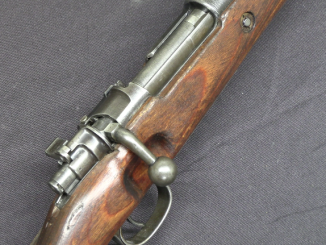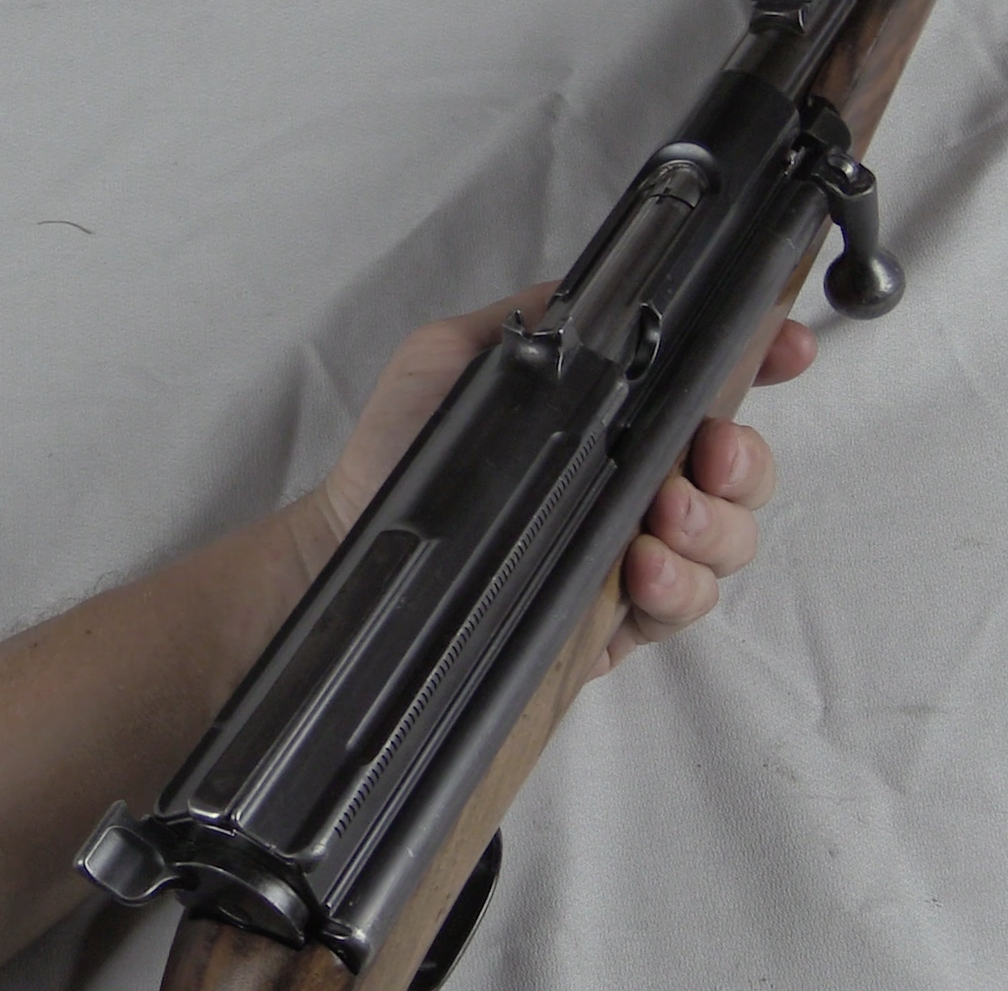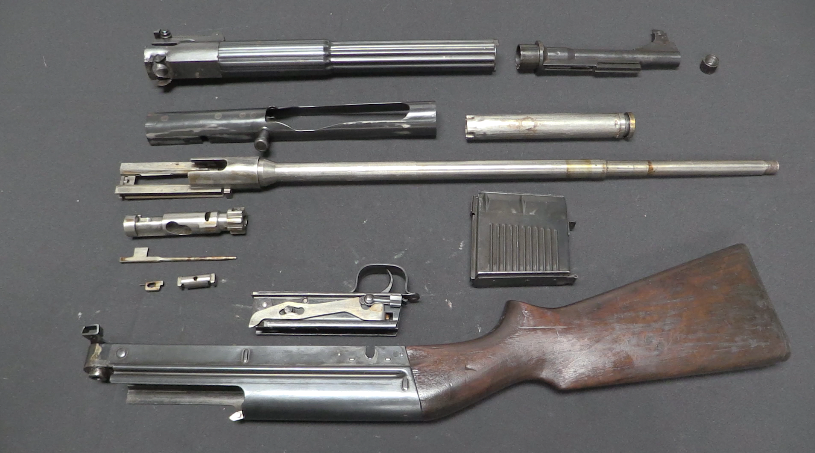Germany was one of the first nations to really get into the sniping business during World War I, and this is an example of their sniper rifle of the period. The base rifle is a standard Gewehr 98 in 8mm Mauser. Optics form a multitude of different commercial manufacturers were used, mostly 3x and 4x in magnification. There was no specific military scope pattern. Unlike today’s much more developed telescopic sights, this type had its windage adjustment built into the mount instead of the scope, and used a BDC (bullet drop compensator) elevation dial which moved the reticle up and down in the scope’s field of view.
Related Articles

Bolt Action Rifles
Spoils of War: French Occupation-Production Mauser K98k svwMB
Allied troops occupied the Mauser factory complex in Oberndorf in April of 1945, right at the end of the war. The factory was put under French administration and by May that same year production lines […]

Gunsmithing
Mauser 1902 Prototype Long Recoil Rifle at James D Julia
Paul Mauser was very persistent – if ultimately unsuccessful – in his long-tim goal to create a practical semiautomatic rifle using a full-power cartridge. In total he tried some 17 different designs, including one in […]

Prototype
RIA: Walther A115 Prototype Rifle
The Walther A115 was one of the semiauto rifles developed in pre-WWII Germany. Apparently only three were made, and it uses a neat combination of sheet metal construction with a rotating bolt and annular gas […]

Otto Bock being really much better known for his creation of the 9.3×62 cartridge. Also a rather unusual reticle by German standards, having both the three-post design of the No 1 and the fine crosshair of the Nr 4.
Actually three posts with fine crosshairs is a german number 4 actually. Crosshairs only is a number 6 reticle. Of course each manufacturer has its offering of own flavours of reticles that differ slightly from each other.
See for example here:
http://www.triebel.de/optik/absehen_normal.html
“I’m… probably a little too excited about that particular feature.”
That’s what makes watching Ian so fun.
It bears to remember that old optics get dirty and quite often there’s some fungus growing inside. I think there is some in this scope as well. So, usually they look worse than they did as new.
Yuck! No wonder scopes usually don’t survive past their usual service life…
Why is the fish-eye feature a bad thing?
It makes my hips look fat…
Distortions aren’t good for your field of view…
Mostly because it makes tracking difficult when the target is moving across your field of view. As the target gets close to the “edge” of the field unless your panning technique is good, you can lose it even before it passes beyond the edge of field.
Although in the static conditions of the trench war, this probably wouldn’t have mattered too much. Targets- meaning men- didn’t move that much or that fast.
Generally, a sniper would have been engaging targets like artillery spotters, lookouts, sentries, MG, mortar, or artillery crew, and officers. Plus just anybody fool enough to stick his head up too far over a parapet. None of the above would have much lateral movement.
BTW, the German WW2 sniping “system” wasn’t much more evolved or coordinated than the WW1 version. There were half-a-dozen different “standard” scope setups, mostly with commercial scopes by Hensoldt, Unertl, Voigtlander, etc. And the rifles were anything from standard K98Ks “selected for accuracy” to reworked WW1 “Lange 98s” to commercial sporting rifles “commandeered” by the Wehrmacht and SS. SS snipers favored Mannlicher or Mauser sporters in 6.5mm when available for their better accuracy and higher effective RoF due to lower recoil, according to novelist and historian Stephen Hunter- see The Master Sniper, one of the better, and better-researched, fictional treatments of the subject.
The one actual intended “standard” sniping setup used during the second go-around was the 4X ZF4 scope on the K43 semiautomatic rifle, which never reached full production status;
http://www.snipercountry.com/Articles/HistoricSniperScopes_GwZF4fach.asp
More common was a very small scope, the 1.5X Zf.41, mounted in place of the standard tangent rear sight on (once more) a “selected” K98K, in an arrangement that most likely strongly influenced Col. Jeff Cooper’s “Scout Rifle” concept;
http://www.mauser.org/wp-content/uploads/2012/09/ZF41-10-620.jpg
Either one would probably get the job done.
Also, more than a few WW1 issue K98 sniper rifles had been “stashed” along with everything else by the Reichswehr following the supposed Versailles treaty “disarmament”, while blandly claiming that they had been destroyed by their “owners” rather than being surrendered. Not to mention the ones “souvenired” by soldiers who brought them home “just in case” and had them in hand when they joined a “sport detachment” or some such. Many were arsenal reconditioned in the 1930s as Germany officially rearmed. They tended to be put together from parts on hand, and no, the numbers often didn’t match.
So it’s entirely possible that this rifle served in the second war in addition to the first.
cheers
eon
Well, of course this scope seems better for dealing with high-priority static victims. Trenches aside, snipers with such a system tend to do what’s called camping, right? Set up the field so incoming opponents can’t use mobility to lessen the likeliness of getting killed. Obstacles like rocks, mud, and just plainly thick forest tend to make for a sniper’s best friend when he’s deep in the woods disguised as a bush (or in winter, a snow pile). With a non-ideal terrain for infantry mobility in place, iron sights can be used if you’re good enough since they don’t glitter!
Did I mess up?
Nope. You’ve pretty much described sniper warfare generally, especially the WW1 Flanders Edition.
Another way to get around the objective glint problem is to make a tube of cardboard, manila folder, pasteboard map tube, etc., just big enough to slide over the outside of the scope’s objective (front) “bell”, and tape it in place.
Make it about 6 to 8 in (15-20cm) long, and it will pretty effectively “hide” the objective from reflected light when seen from the front. Result; no “glint”, and it won’t bother your field of view. (I could explain why, but that takes a few pages of equations regarding focal length, etc., and an MA in Optical Physics helps.)
Painting the inside of the tube flat black is an additional refinement that further reduces reflection back into your objective from nearby surfaces in front of your position.
Some modern purpose-built sharpshooter’s scopes (both military, police, and even ones for purely target-type benchrest shooting) come with such “sunshade” tubes today, right OOB. They’re mostly made of plastic or aluminum.
cheers
eon
PS to Ian;
I tried to link to your article on the Zf.41, but Firefox refused, stating that your security software was OOD. There may be a glitch in FF that needs to be addressed. (Sledgehammer, anyone?)
cheers
eon
The hook is primarily for piling/stacking arms isn’t it?
I figured that would be done by the cleaning rods…
Great sniper rifle. I dream to show with this gun.